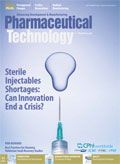Best Practices for Cleaning Validation Swab Recovery Studies
Swab recovery parameters are reviewed in detail to define best practices and highlight common mistakes to assure successful recovery studies using a risk-based approach.
ZenShui/Odilon Dimier/Getty Images
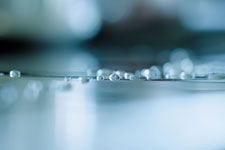
Submitted: October 12, 2015
Accepted: December 2, 2015.
Parameters affecting cleaning validation swab recovery studies include: the material of construction coupon, residue spike level(s), swab recovering the residue, swab personnel, swab extraction, and test method. Each of these swab recovery parameters are reviewed in detail to define best practices and highlight common mistakes to assure successful recovery studies using a risk-based approach.
Residue assays are a critical quality attribute in establishing a validated cleaning program. They are essential to accurately determine amounts of residual API or formulation component in comparison to the acceptable residue limit (ARL) for a given cleaning process or equipment train (1). The residue assays are validated for the following parameters: linearity, precision, sensitivity, specificity, detection limit (LOD), quantitation limit (LOQ), and recovery. From an analytical standpoint, recovery is from the cleaning test sample (i.e., the swab). From the cleaning program standpoint, the concern is the recovery of the residue from the manufacturing equipment.
Recovery process
Recovery factors for cleaning validation residue testing are an essential element of any cleaning validation program. The FDA Guide to Inspection of Validation of Cleaning Processes states that firms need to “show that contaminants can be recovered from the equipment surface and at what level…” (1). The updated EU Guidelines for GMP Annex 15 expands this concept to state that “recovery should be shown to be possible from all materials used in the equipment with all sampling methods used” (2). The Health Canada (3) and the Pharmaceutical Inspection Convention and Pharmaceutical Inspection Co-operation Scheme (PIC/S) (4) cleaning validation guidances also require that recovery experiments be completed. Recoveries are necessary for direct surface sampling using a swab.
It is a common practice to set baseline limits for a minimum acceptable recovery, for example, a minimum product recovery of 70%. However, the most important aspects for product residue recovery factors are that the data are consistent, reproducible, and provide an adjusted ARL that is higher than the analytical test method LOQ. ARLs must also be achievable and practical. If recoveries are too low, the recovery parameters should be investigated and optimized to increase recovery. If swab recoveries cannot be improved, a low recovery can be used with the understanding that the accuracy and precision are somewhat compromised and a higher variability (% relative standard deviation [RSD]) criteria will most likely be necessary.
Although it does not occur as often, recoveries that are too high should also be a concern. Recoveries of API residues rarely are above 100%, but it is more common for recoveries of detergent to be above 100%. However, consistent recoveries above 100% should be a cause for concern. Single recoveries up to 105% can be considered acceptable, but any recovery greater than 105% should be considered suspect and investigated.
A recovery factor is determined through experiments in which sample equipment materials of construction (MOC) spiked with known amounts of the substance of interest are recovered and tested. The recovery must be capable of capturing a sufficient amount of material to allow an accurate and precise measurement of the spiked component. As shown in Figure 1, blank samples are also tested to assure that the swab recovery components do not interfere with the test sample analyte of interest. The parameters that go into a successful swab study include the coupon MOC, residue spike level, number of spike levels and replicates, recovery factor determination, swab area, swab, number of swabs, swab solvent, swab technique, personnel, sample container, extraction solvent, extraction method, extraction time and test method.
Figure 1: Swab sample recovery study design.

There is some flexibility with all of these parameters. Flexibility allows one to optimize the recovery procedure. Spike levels, volumes, times, and materials can all be changed to benefit the recovery process. The parameters, however, can be made too diverse or overly conservative, which will take more time and resources with little or no added value to the recovery. Also, many of the parameters influence the flexibility of other recovery parameters. Once a recovery parameter is set, it could limit other parameters, resulting in a recovery that is not optimized.
Best practices for selection and execution of swab recovery parameters are defined to increase efficiency. Common mistakes are noted as potential pitfalls to avoid. Some parameters are fairly straightforward, while others are more subjective to the individuals defining the process.
Coupon material of construction (MOC)
The obvious first choice for coupon MOC is stainless steel, which comprises the majority of material in pharmaceutical manufacturing equipment in many plants. Regulatory expectations are that recovery studies are performed from every product-contact MOC, regardless of how prevalent it is in the manufacturing equipment. For example, gaskets with very little product-contact surface area require recoveries because they typically represent a worst-case location, and these types of materials have been the source of recovery issues in the past (5). Testing every MOC for every product is the more conservative approach, but can be labor- and resource-intensive.
Reductions in the amount of testing for a cleaning validation program are desirable, but efficiencies must have technical merit and be scientifically justified. Within a company, for each new drug product manufactured, quantitative studies determine acceptable swab recoveries from each MOC that requires surface sampling. One of the ways to reduce the amount of testing is to test a new substance on only a subset of materials. Data have shown (5) that MOCs can be grouped based on existing recovery data. A follow-up study (6) concluded that MOC porosity was a contributing factor to low recoveries of swab samples from MOC coupons. If feasible, porous materials should be replaced to avoid the possibility of residue from the porous material contaminating the next batch.
The recommended strategy for recovery studies is to perform the recovery studies on stainless steel for all products or compounds. Then take a subset or cross-section of the products or compounds and perform recovery studies on all MOCs at the site. If the data generated agree with the literature groupings, then continue using stainless steel for recovery studies and perform recoveries from other MOCs as necessary. If the recovery data generated do not agree with the literature groupings, then continue using all MOCs for recovery studies until enough data are generated to allow grouping at the site.
Recovery spike level
The swab recovery study should be centered on the ARL for the product or compound. Accuracy is most important in the region of possible cleaning failure. The range should be extended above the ARL, approximately 25%. Any higher is unnecessary because the cleaning procedure fails at any level above the ARL. The recovery range can go down to the LOQ (see Figure 2) of the method because most cleaning data should be near or below the LOQ of the analytical method.
Figure 2: Swab recovery range. ARL is acceptable residue limit.
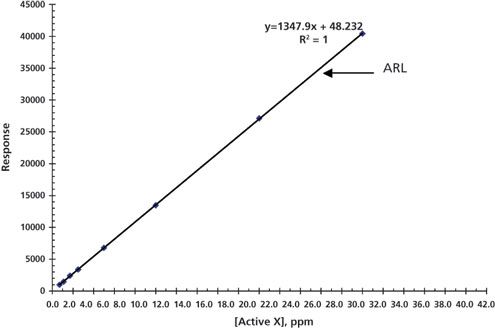
The recommended strategy for recovery levels is to spike 125% of the ARL, 100% of the ARL, and 50% of the ARL at a minimum, and to extend down to the LOQ of the test method as practical.
Number of swab recovery levels and replicates
All recovery levels should be done in triplicate, to allow for variability of the factors affecting the recovery. There should be at least three recovery levels for each recovery study: at the ARL level, one above the ARL, and one below the ARL. Each additional recovery level results in three recovery assays for each product on each MOC. A balance needs to be struck between the amounts of data needed against the amount of work required to generate the data. An additional factor affecting the number of recovery levels is the number of products requiring recovery. The fewer the products, the greater number of recovery levels can be conveniently spiked, recovered, and tested.
Table I: Example of swab recovery study data. RSD is relative standard deviation.
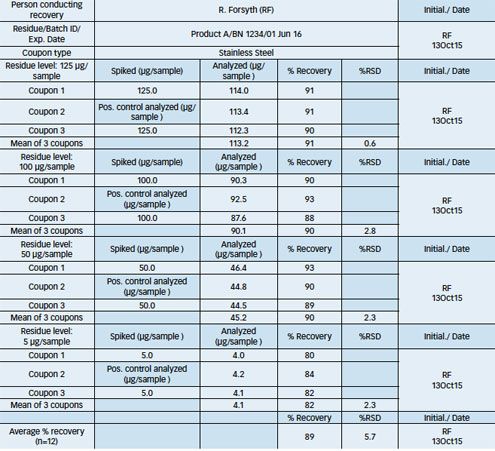
The recommended strategy is to perform triplicate recoveries at the four levels noted above. An example of a recovery data set is shown in Table I. The recoveries at the three higher levels should be at least 70% and should agree within a %RSD of 15%. If the average recoveries are <70% or >105%, an investigation should attempt to optimize the recoveries. If the recovery at the LOQ agrees with the other three, then the range is extended. If the recovery at the LOQ does not agree with the other three, then the limitations of the accuracy at low levels is known, the risk of which decreases the further the ARL is from the LOQ of the test method.
Recovery factor determination
The recovery factor is determined from the recovery data generated from the spiked
coupons. There should be at least nine data points from three different spike levels. The data for the three levels can be averaged to determine the recovery factor. Recovery data can be somewhat variable; therefore, a variability limit is also used. Typically, a %RSD of <15% is considered acceptable variability, although experienced personnel can perform recoveries at <10% RSD. If data for additional spike levels are generated, all data in the recovery average should be included.
If the variability of the data exceeds the 15% variability parameter at lower levels, they should not be included in the average for the recovery factor. This approach will not impact the resulting cleaning data. For example, a swab result of 0.1 µg/swab will not change for recovery factors between 50-100%. The importance of the accuracy of the data near the LOQ of the method is inversely proportional to the importance as the accuracy of the data near the ARL based on the difference between the two levels.
A seemingly conservative approach is to use the single lowest recovery as the recovery factor. Scientifically and statistically, this approach does not make sense. Scientifically, using this approach would cause samples near the ARL to fail cleaning when in fact they pass. Statistically, the single lowest recovery is not representative because it ignores the majority of the recovery data. Qualification of personnel is also compromised when tested by? a lower recovery factor. The potential damage caused by this approach increases the further the lowest value is from the average.
The recommended approach is to use the average of the recovery data set as the recovery factor for all cleaning samples.
Swab area
The size of sample area to take will dictate several of the recovery parameters. A sample size of 5 cm x 5 cm area (25 cm2) has been accepted as large enough for a representative sample size (7) and is small enough for areas that have limited surface area and/or require taking multiple samples from the same location (e.g., API and detergent). There are multiple practical advantages for taking a 25-cm2 swab sample. A 25-cm2 sample size almost always requires only one swab to achieve adequate recovery. It is also less likely to require the need for a template to take a 25-cm2 sample.
Taking a larger sample size, for example a 10 cm x 10 cm area (100 cm2), although resulting in a larger sample size and a potentially lower LOD for the residue assay, is limited to sections of the manufacturing equipment that have sufficient surface area to accommodate these samples, which usually are not the hardest to clean sections of the equipment. Many hard-to-clean locations (e.g., equipment outlets) do not have sufficient area to take an API and detergent sample and would be difficult to justify. Because of the larger swab area, swabs wetted with volatile organic solvents have a greater tendency to dry out before swabbing the entire area, making recoveries more difficult. It is also advisable when taking a larger sample area to make a final swab pass around the perimeter of the swab area to pick up residue that has been pushed to the sides of the swab sample area. The larger sample size is more likely to require the need for a template and the problems associated with that, including sample cross-contamination. A larger swab area would increase the need to use multiple swabs and could increase variability among personnel.
A large swab area will also limit flexibility of other swab parameters including the swab chosen for the recovery, the number of swabs used for the recovery, and volume of extraction solvent. The disadvantages of using a larger swab area far outweigh the advantage of obtaining a larger sample. Thus, the recommended strategy is to swab a
5 cm x 5 cm area (25 cm2).
Swab characteristics, material, and size
Swabs and swab materials should be convenient to use, able to pick up residue from coupon and equipment surfaces, release residues into solution, and not cause interference with the residue assay. There are several types of swabs and vendors, but the most popular is the Texwipe brand of swabs. Other vendors include Berkshire and Lym Tech. The swabs are made of a woven polyester fiber that wets with most solvents. It adsorbs the dissolved residue material, removes it from the surface being tested, and releases the residue into the extracting solvent. Texwipe swabs contain no adhesives and only exhibit interference peaks when they are extracted with a strong organic solvent, such as acetonitrile, over an extended period of time. There are also low total organic carbon (TOC) and sterile swabs for TOC and bioburden applications respectively.
Swabs come in two general sizes, large and small (see Figure 3). A mistakenly conservative approach is to default to the large swab size to better assure that the residue is sufficiently recovered. In fact, the smaller swab head can adequately recover several hundred micrograms of residue from a coupon. This should be a high enough level for just about all recovery studies and allows more flexibility with other recovery parameters. The small swab head uses 0.1 mL of swab solvent and can be extracted into as little as 2 mL of extraction solvent. The larger size swab head requires more swab solvent 0.5 mL) and a greater volume of extraction solvent, and it limits the sensitivity of the analytical method.
Figure 3: Examples of different swabs.
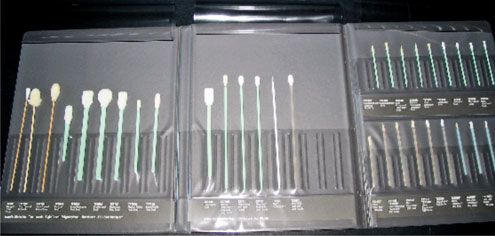
The recommended strategy for swabs is to select one model of small size swabs for all recovery studies. Only resort to a large swab if other options are exhausted, because having different swabs available for swabbing could lead to using the wrong swab, resulting in a non-conformance.
Number of swabs
As noted in the previous section, the sample area and the swab can influence the number of swabs necessary for adequate recovery. A single swab will provide adequate recovery, require a minimal extraction solvent to maximize the LOD for the residue assay, and simplifies the swab process to take the sample. A larger area will more often require multiple swabs to achieve a sufficient recovery factor. If using multiple swabs, it must be determined whether to use a wet or a dry swab for the second swab, but multiple swabs will increase recovery on an incremental basis only. Multiple swabs will also require a larger extraction solvent volume and potentially limit any advantage gained form the increased sample size. Using multiple swabs increases the work of the swab personnel (i.e., two swabs is double the work of a single swab). Using multiple swabs also increases the risk of mistakes and potential contamination of the equipment.
The recommended strategy is to use a single swab for recovery. If adequate recoveries cannot be achieved, other recovery parameters should be explored, including swab solvent and the extraction technique and time, before resorting to using multiple swabs.
Swab solvent
The swab solvent must be one in which the analyte of interest is soluble and be compatible with both the extraction solvent and the analytical test method. The best choices are purified water or an organic solvent that will evaporate and leave no residue behind, for example isopropyl alcohol (IPA), which is often used as a final wipe or rinse of equipment to aid drying and removal of any residual water.
If the samples are being analyzed using TOC analysis, the swab solvent is limited to purified water. If high-performance liquid chromatography (HPLC) is used for analysis, then the choice of swab solvent is more flexible. The amount of swab solvent is important and somewhat technique related. The swab needs enough solvent to wet the entire surface to solubilize and recover the residue of interest, but not so wet that solvent is left behind on the coupon. This amount will differ slightly for water and organic solvents and for small and large swab heads. As noted previously, small swab heads hold approximately 0.1 mL of solvent while the large swab heads hold approximately 0.5 mL of solvent.
The recommended strategy is to thoroughly wet the swab head in the solvent and then squeeze the excess solvent from the swab head using the side of the solvent container. It is important to ensure that both sides of the swab are squeezed out.
Swab technique
The swab technique has always been assumed to be a major factor in the variability of swab recovery data. Although person-to-person variability is a factor, it has been shown that this variability is fairly consistent across sites (5), making swab recovery factors transferrable among sites.
There are numerous descriptions of swab technique, and generally most are acceptable, as long as the technique is described in sufficient detail for ease of training, and covers the sample area completely and consistently. The swab technique should be successful for performing recoveries and routine swab sampling. One of the best and most practical is also the most straightforward.
The recommended strategy is to wet a swab with solvent. Remove any excess solvent from the swab as described previously. Swab an area of 25 cm2 (5 cm x 5 cm).
Using the flat side of the swab, apply slight pressure to the swab stick and make full contact with the surface. Swab the surface using a back-and-forth motion for about 10 seconds. Flip the swab over and swab the surface in a perpendicular direction using a back-and-forth motion for about 10 seconds (see Figure 4). Cut the swab above the swab head into the sample container. Cap the sample container. Repeat the process for each recovery or sample location.
Figure 4: Swab technique.
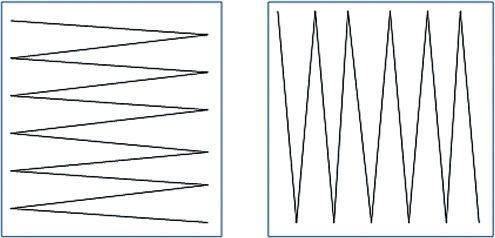
Swab personnel variability, and qualification
Personnel performing the recoveries have an effect on the outcome of the recovery study. Variability is generally inversely proportional to the training and experience of the personnel. All personnel should be thoroughly trained on the techniques involved
in a swab recovery. The easiest way to train swab personnel is to have them involved in the initial recoveries to establish the swab recovery factors.
Qualification of personnel that perform swab sampling demonstrates successful training and is a regulatory expectation. Personnel must demonstrate that they can accurately and consistently recover residue from MOC coupons. This ability can be demonstrated through participation in the recovery studies. Otherwise, multiple coupons are spiked with API or product and personnel recover the residue. The recovery obtained must pass acceptance criteria for accuracy and precision.
The recommended strategy is to have personnel participate in recovery studies and meet the criteria noted above: greater than 70% recovery with less than 15%RSD. For qualification, personnel perform recoveries of a single API from three coupons at the ARL level.
To qualify to perform swab sampling, the average of three recoveries at the acceptance criteria must be within 15% of the established recovery factor with a %RSD of <15%.
Sample container
The sample container stores the swab sample until it is delivered to the laboratory for assay. The sample container must be large enough for the volume of the extraction
solvent, be compatible with the extraction solvent, and not contain anything that might be extractable into the solvent and a source of contamination (extra peaks or higher TOC value) in the extracted sample. General-use glass vials with lined caps have been known to cause issues with cleaning sample analysis.
The recommended strategy is to use inert, disposable vials. Examples include plastic centrifuge vials and glass TOC vials. It should be ensured that any plastic vials used are compatible with the extraction solvent.
Most solvents used for HPLC analysis are compatible with these type of centrifuge vials. The glass TOC vials with Teflon-lined lids are acceptable, but tend to be more expensive.
Extraction solvent and volume
The extraction solvent will be adapted from the validated test method. It will be compatible with the analytical test method and will dissolve the analyte of interest. If using TOC, the extraction solvent must be purified water.
The volume of extraction solvent will depend upon the cleaning limit, the test method sensitivity, and the size of the swabs. TOC testing typically requires 30-40 mL of purified water for extraction based upon the sampling needs of the instrument. For HPLC testing, the extraction solvent requirements are far less. For a single small swab head, the minimum volume can be as little as 2 mL, although typical extraction volumes are in the 5-10 mL range.
The recommended strategy is to use a minimum practical volume of extraction solvent because the majority of cleaning samples are expected to have little or no residue. Nonetheless, the volume of extraction solvent should result in a sample concentration such that a sample at the cleaning limit falls within the linear range of the test method.
Extraction technique and time
The most common swab extraction techniques are: vortex mixing, shaking, or sonicating. The technique and length of time used depend, to some extent, on how long the swab samples might sit before they are processed. If samples will sit for a relatively short time, for example less than one day, and they do not dry out, then vortex mixing for up to one minute might be enough to effectively extract the sample from the swab. If the swab samples will be held for a longer period of time, or if there is a chance they could dry out, a more vigorous, longer extraction is probably necessary, such as mechanical shaking or sonication for a period of 15-30 minutes.
A comprehensive approach to establish extraction conditions is to take a residue and spike aliquots onto swabs and let the swabs dry completely to approximate worst-case conditions. Extract the swabs in multiples of three under increasingly rigorous conditions and then assay them. Choose extraction conditions at least rugged enough to extract the sample consistently with good recovery.
The recommended strategy is to match the extraction technique and time to the anticipated hold time for the swab samples prior to extraction and apply the sample extraction parameters to all cleaning validation swab samples for consistency going forward.
Test method
Testing of cleaning validation samples requires a validated test method. The extent of validation is dependent upon the type of method employed and the capabilities of the method. For any test method to be suitable for its intended purpose, it must be appropriate for measuring analytes at and below the ARL. The analytical performance characteristics, or validation parameters, as defined by the United States Pharmacopeia (USP) (8) include: accuracy, precision, specificity, detection limit, quantitation limit, linearity, range, and robustness.
Even if they are well below the ARL, establishing the LOQ and LOD of the method are important. Because the expectation is that most cleaning validation samples will assay at zero or below the method LOD, the LOQ and LOD parameters greatly help define and put context around the process capability of the cleaning procedure. Without the LOQ and LOD, there would be far less information regarding the effectiveness and control of the cleaning procedure, and the cleaning procedure could be drifting towards being out of control before any data makes it evident.
The swab recovery study should be part of the method validation. Once method parameters are established and validated, the swab recovery should be executed to assure that the method will provide meaningful swab sample data.
Unless all samples are going to be tested immediately, then sample solution stability should be established. This evaluation would include stability of the unextracted swab as well as the extracted swab solutions. Stability of at least two to three days is recommended in case of instrument failure during testing, or if unexpected results need to be confirmed.
Test methods such as pH and conductivity, while limited to certain residues, can provide cleaning data and require only instrument calibration. Many analytical test methods require validation. The most prevalent of these methods requiring validation are discussed in the following.
HPLC for testing of cleaning validation samples is well established (9-12) and can address all validation parameters. HPLC is a chromatographic method that involves a sample in a liquid stream that passes through a packed column and separates from the other components of the sample. An HPLC method can separate the residue of interest from the components of the formulation as well as the detergent. A well-designed HPLC recovery study can demonstrate accuracy, precision, linearity, range, LOD, and LOQ in a single run. Typically, HPLC methods for assay are designed to quantitate levels down to 0.1% of the API, making sensitivity well below most calculated ARLs. However, the sensitivity of HPLC is dependent on the chemical structure of the residue of interest and the detector, which can quantitate the residue. A residue with no UV chromophore requires either a specialized detector (fluorescence, electrochemical) or derivatization to achieve the desired sensitivity. HPLC assay methods can be lengthy (i.e., 30-40 minutes per injection), which could be an issue for quick turnaround of samples.
TOC analysis is also well established for testing cleaning validation samples (13-15). TOC analysis involves the oxidation of carbon and the detection of the resulting carbon dioxide produced from the oxidation reaction. Sensitivity is down to the ppm or ppb level. TOC is a non-specific method of analysis. All organic carbon is detected. Therefore, any residue detected must be considered the residue of interest. A well-designed TOC recovery study can also demonstrate accuracy, precision, linearity, range, LOD, and LOQ in a single run. Residues for TOC analysis must dissolve in water. This requirement could limit the effective linear range of the residue assay. Other types of chromatography or spectrophotometry are appropriate for testing cleaning validation samples as long as they are validated and have sufficient sensitivity.
The recommended strategy is to select a familiar method with which the operator has experience. Validate the method using all validation parameters and then execute the recovery study.
Figure 5: Interrelationship of swab study parameters. ARL is acceptable residue limit; MOC is material of construction.
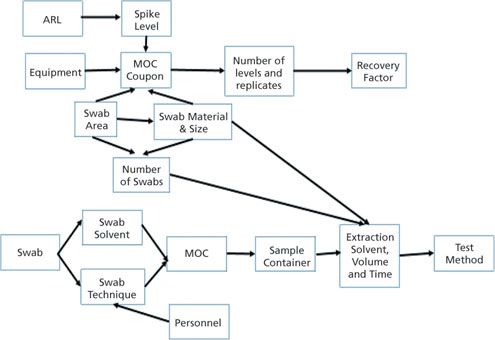
Conclusion
Swab recovery studies are a critical part of a cleaning validation program and must be executed in a scientifically sound, compliant, and consistent manner. The parameters of a swab recovery study can enhance or limit the value of the recovery study and, therefore, all of the data generated in support of the cleaning validation program.
Table II: Swab recovery best practices
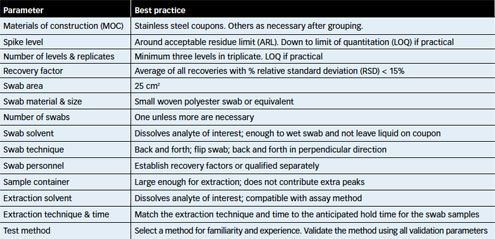
Best practices are shown in Table II and, as shown in Figure 5, the components of the swab study affect one another based on the choices made. The choice of swab area and swab selection also affect subsequent parameters all the way to the sample test results. A well-designed and well-executed swab recovery study can help ensure a robust site cleaning validation program.
References
1. FDA, Guide to Inspection of Validation of Cleaning Processes (Division of Field Investigations, Office of Regional Operations, Office of Regulatory Affairs, Washington, D.C. July 1993).
2. EC, EU Guidelines for Good Manufacturing Practice for Medicinal Products for Human and Veterinary Use, Annex 15: Qualification and Validation (2014).
3. Health Canada, Cleaning Validation Guidelines (Guide-0028) (2008).
4. PIC/S, Recommendations on Validation Master Plan, Installation and Operational Qualification, Non-Sterile Process Validation and Cleaning Validation, 2004.
5. R. J. Forsyth, J. C. O’Neill, J. L. Hartman, Pharm. Technol., 31 (10) 102-116 (2007).
6. R. J. Forsyth, J. Pharm. Technol., 15 (4) 91-96 (2009).
7. G. L. Fourman and M. V. Mullen, Pharm. Technol., 17 (4) 54-60 (1993).
8. USP 30-NF25, 680-683 (2007).
9. A. H Schmidt, J Liq. Chrom. & Rd. Technol., 29 (11) 1663-1673 (2006).
10. M. A. Boca, Z. Apostolides and F. Pretorius, “J. Pharm. Biomed. Anal., 37 (3) 461-468 (2005).
11. R. J. Forsyth and D. Haynes, Pharm. Technol., 22 (9) 104-110 (1998).
12. E. Pang et al., Pharm. Technol., 29 (1) 84-94 (2005).
13. K. M. Jenkins, et al., PDA J Pharm. Technol., 50 (1) 6-15 (1996).
14. J. Walsh, “Using TOC Analysis for Cleaning Validation,“ presented at
The Validation Council’s Conference of Cleaning Validation, Eton, NJ
(Oct. 27, 1999).
15. R. Clifford and M. Tanaka, Pharm. Technol., 36 (8) 52-55 (2012).
Abut the Author
Richard J. Forsyth is a senior consultant at Forsyth Pharmaceutical Company, 907 Shamrock Ct. Royersford, PA 19468, forsythpharmaconsulting@gmail.com.
Article Details
Pharmaceutical Technology
Vol. 40, No. 9
Pages: 40–53
Citation:
When referring to this article, please cite as R. Forsyth, “Best Practices for Cleaning Validation Swab Recovery Studies," Pharmaceutical Technology 40 (9) 2016.
